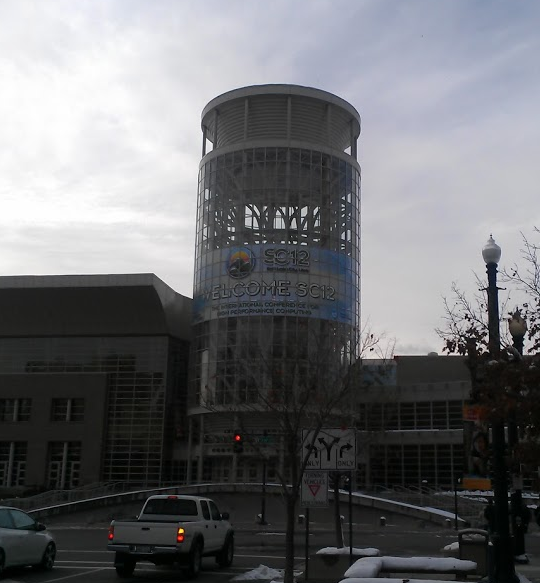
I’ve got my pictures from the event up in an album in google’s cloud.
Here are the big, cool things I learned on the floor or at the various evening events:
- Xeon Phi. Xeon Phi everywhere. Intel may have backed off on Larrabee, but the MIC descendants are proliferating quickly, and appear to actually be in use. They really are interesting parts – 60 node Linux x86 SMP box attached to a host system over PCI Express via a network-like interface. Somewhere between a tiny desk-side cluster and a GPU with a programming model you can actually use.
- The population was much less male dominated than is typical for computing events. This is always a good thing.
- The average age of attendees also seemed to be down by the better part of a decade.
- The national labs losing their booths to the government-wide travel restrictions (apparently some folks went junketing in Vegas and it was that bad) changed the feel of the floor. Fewer, but longer and deeper conversations. More open layout, because many of the usual big constructed booths belong to the national labs. Users from the national labs hanging out at vendor’s booths. Not altogether a bad thing, but it was quite different.
- ARM64 (aka aarch64, aka ARMv8). It is happening. It is odd (64KB pages, etc.). Large companies are being bet on it. We’re talking many billions of dollars, biggest bet since Itanium kind of big. The priority seems to be avoiding the Itanium mistakes, making sure the designs arrive promptly, and making sure software support is ready. Dell is talking quietly, Calxeda is gunning for it, Nvidia was showing (but only quietly) plans, AMD is being pointed to as a likely leader, and ARM was is sitting in their little 10×10 booth along one wall of the exhibit floor looking very pleased with themselves.
- AMD is dying. The untimely (and vigorously denied) rumor that they hired J.P. Morgan to begin plans to sell part or all of themselves made it look even worse, but they had almost no presence on the floor, and scheduled a tiny booth next year.
- We talked to a number of networking vendors making interesting things (free-air optical switching, multi-port Ethernet NICs, etc.). Infiniband is so good and so cheap (in a relative sense) for cluster applications right now that everyone else is hunting for an edge. This is a good thing for researchers.
There will be at least one more SC12 post later, when my cube of schwag arrives. The T-shirt harvest was great this year…

